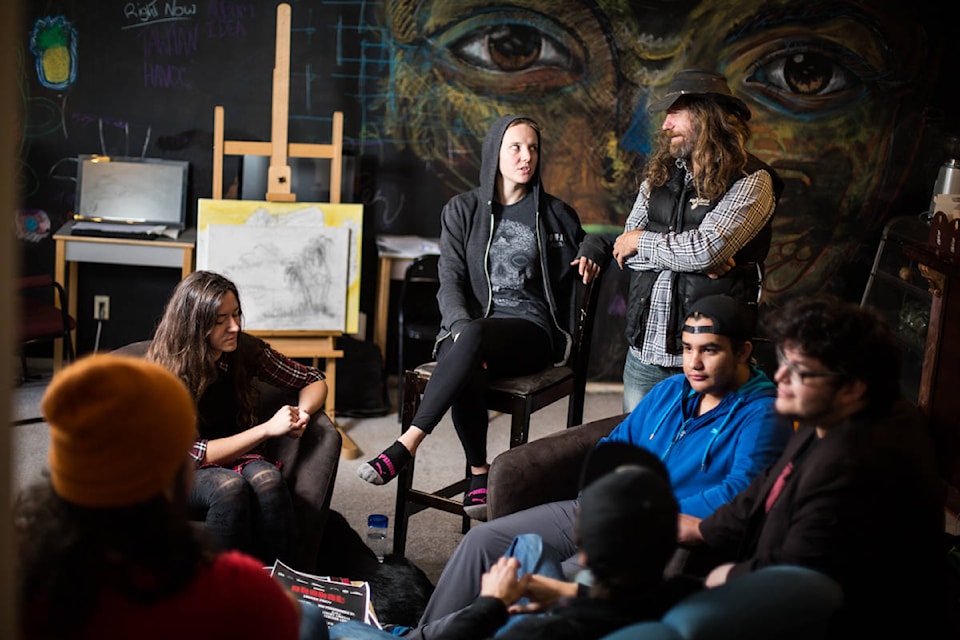By Jesse Winter
Jesse Winter
News Reporter
While 17-year-old Cassis Lindsey’s peers were enjoying the endless Yukon summer days, she was digging through reports about sex trafficking.
When her friends were getting ready for the new school year, Lindsey was interviewing the service workers who help support survivors of the Whitehorse’s underground sex work industry.
As a contributor to the newly-reborn Shakat Journal, Lindsey’s story on sex trafficking in Whitehorse — “Hiding In Plain Sight” — is one of many that takes an unflinching look at the challenges facing Yukon youth today.
“We don’t think much about it,” Lindsey says. “We assume people trade sex for some things, but no one actually thinks about it in depth. I was curious. I wanted to know more, and I was shocked by some of the stuff I read.”
Lindsey’s story takes a 30,000-foot look at the workings of the sex trade. It’s based primarily on a report about the sex trade in Whitehorse produced by the Yukon Status of Women Council. The report has not been made public, but Lindsey was given a copy to base her writing on. She backstopped it with interviews with frontline workers.
It’s a heavier topic than most high school students would be used to tackling, but an important one, Lindsey says.
“You really need the awareness. If you don’t have the awareness, it’s never going to get better, and people won’t work towards making it better,” she said.
According to Paige Hopkins, Shakat’s new editor-in-chief, that ethos underpins the journal’s whole mission.
“It’s not all fluff pieces because our lives are not all fluff pieces,” Hopkins says. “Kids up here deal with some really hard stuff. We can’t shy away from that.”
The Shakat Journal existed once before, decades ago, as a summer newspaper aimed primarily at tourists promoting Yukon First Nations culture and art.
Youth of Today Society’s Lance Burton happened across an old copy of one at the city’s youth drop in centre and figured it was worth trying to revive.
“I said hey, look at this old beautiful thing, this voice that’s not there anymore,” Burton said.
So he pitched the idea to the society’s managers, and the idea quickly gained steam. Originally it was meant to be a small single printed edition and a feasibility study looking at whether the project could survive long-term.
In the span of a few months, it’s grown to be much more than that. It’s a beautifully-designed website full of multimedia stories with video, audio and graphic design. It’s a 24-page glossy magazine, with articles including a profile of Kwanlin Dün First Nation Chief Doris Bill, a piece on youth homelessness and Lindsey’s take on sex trafficking.
The whole goal is to use the platform of the old newspaper to be a voice for First Nations youth in the Yukon.
“We’ve been calling it the ‘millennial megaphone’,” Hopkins says.
Along with being a venue for young Indigenous voices, Shakat is also a job for all of its contributors. Everyone who worked on the first publication was paid hourly wages, and Hopkins says they will have a budget to commission freelance work from writers, photographers, videographers and other artists.
The first edition went to press in late August, and the team held a lunch party at the Kwanlin Dün Cultural Centre in mid-September.
After eight long weeks of production work, Hopkins stood in front of a room packed with supporters who turned out to fete the newly-reborn publication. Her eyes brimmed briefly with tears as she thanked the community for its support.
But even with the initial success of the publication, this isn’t the finish line for Hopkins and the Shakat team. While the website and the magazine are impressive productions, there’s still the question of that feasibility study and whether the venture will be financially sustainable.
Burton says he hopes the success of the initial launch will show potential funders that Shakat fills an important gap, providing a voice for youth that otherwise might feel invisible.
The team is also pursuing advertisers and sponsors, preparing grant applications and hoping to see local governments get on board.
One avenue they’re already looking at is project funding for educators.
“And it’s not just writing skills but other multimedia skills,” Hopkins said.
“Music production, film editing, graphic design software skills like I have — we want to be able to provide that for anyone who wants to come and learn it. They can be the next generation of Shakat, or they can go off and do their own thing.”
Contact the Yukon News at editor@yukon-news.com
